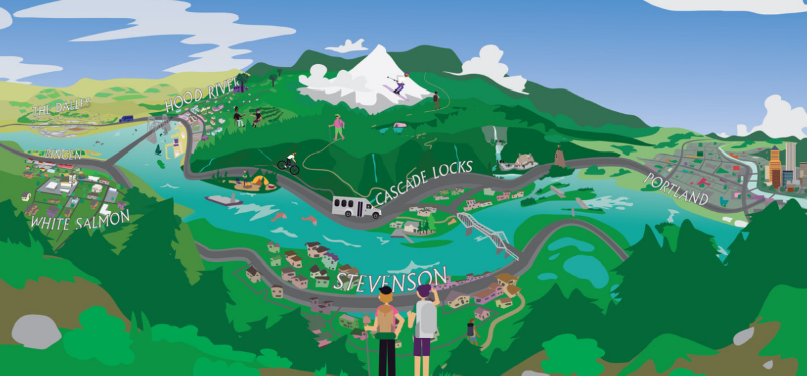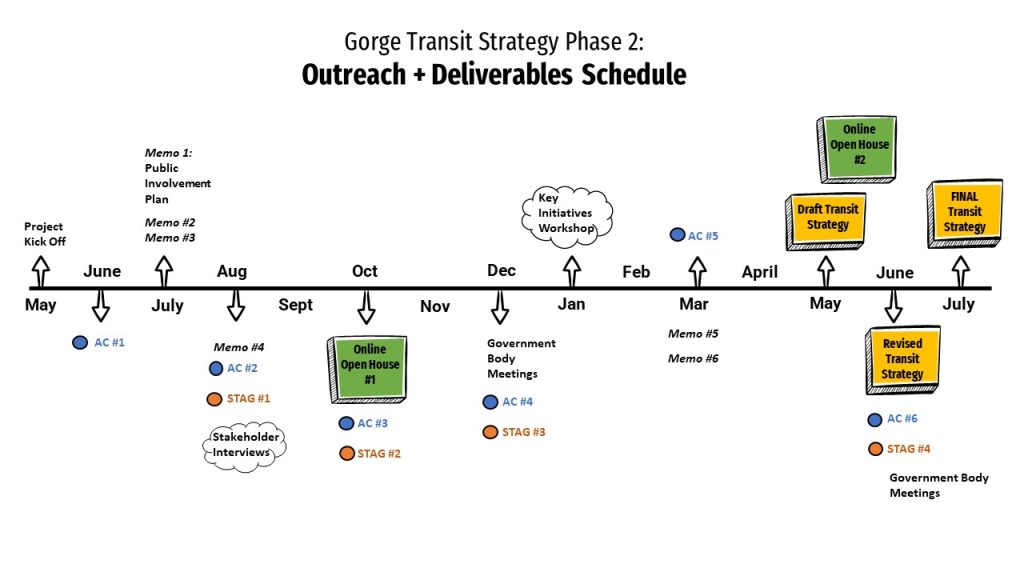Collective Regional Vision: Public transit supports thriving Columbia River Gorge communities by providing access to critical services, higher education, jobs, and outdoor recreation while protecting the natural wonders of the Gorge.

Project Overview
The purpose of this project is to develop a roadmap for a regionally coordinated and integrated public transportation system in a rural 5-county, bi-state region adjacent to the large metropolitan areas of Portland/Vancouver.
What we did in Phase 1
Phase 1 concluded in Winter 2021 and focused on strengthening partnerships, analyzing local transportation plans in the Columbia Gorge, and developing a collective regional vision. The main objective of Phase 1 was to combine the goals, policies, and priorities of local transportation planning efforts to provide a foundation for the work of the regional stakeholders to develop the vision and goals that would guide the implementation strategies of the next phase. Learn more about the outcomes of Phase 1 in the Final GRTS Foundations Memo.
Phase 2
Phase 2 work focused on a more comprehensive implementation strategy including further data analysis, funding and financial planning, assessment of potential regional organizational structures, and operational and policy strategies.
The final document was adopted by each of the five counties with prioritized and actionable strategies and recommendations, including a transit map that clearly articulates the Region’s vision of a successful regional transit system.
Our first online open house and survey was launched fall of 2022. We heard that:
- Increased transit service (i.e., increased service hours, higher frequency) in the Gorge was ranked as the highest priority to help people access places they need to go.
- Increasing first-mile / last-mile access, addressing geographical constraints (more stops, trips, and connections), and smoother transfers were also high priorities for respondents.
- People mentioned the need for transit service across the region. The locations people thought most urgently need transit service added are Lyle, Warm Springs, and Trout Lake.
We also conducted several interviews with local transit providers and agencies about their expectations and goals for the Gorge Regional Transit Strategy. Stakeholders emphasized the importance of the strategy to increase communication, maximize the economy of scale, improve consistency and usability, increase smaller communities’ access to resources, and expand transit ridership.
Feedback shared in the open house and through the interviews were incorporated into the final strategy document.

Project Documents
- Gorge Regional Transit Strategy Phase 2 Memo 6: Key Initiatives
- Gorge Regional Transit Strategy Phase 2 Memo 5: Regional Transit Solutions
- Gorge Regional Transit Strategy Phase 2 Memo 4: Vision and Funding (PDF)
- Gorge Regional Transit Strategy Phase 2 Memo 3: Regional Travel Patterns, Transit Gaps, and Opportunities Analysis (PDF)
- Gorge Regional Transit Strategy Phase 2 Memo 2: Existing Framework (PDF)
- Gorge Regional Transit Strategy Phase 2 Memo 1: Public Involvement Plan (PDF)
- Final Report Gorge Regional Transit Strategy Phase 1: Foundations Memo (PDF)
- Gorge Regional Transit Strategy Phase 1: Public Involvement Plan (PDF)
